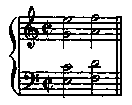Teach Yourself Jazz - online guidebook
For the beginning player, with sheet music samples
| Share page | Visit Us On FB |
|
JAZZ HARMONY 53
Why "wrong"? Well, let's start with the fifths. If you sound together two notes a fifth apart (say
Example 4
 middle C and the G a fifth above) you will notice that this interval has something of a 'buzzing' sound (as compared with, say, the 'sweeter' interval of the 6th). So the 'buzz' in the inside parts of this particular progression tends to stand out like a sore thumb.
"But," you may protest, "I am at the moment, composing a symphonic poem entitled 'Life and Death of a Sore Thumb'. So the sound of sore thumbs is suitable to my purpose, and a general characterless collection of comfortable, unmarked thumbs is not suitable to my purpose." There you may have something.
Now as to the octaves. If two parts run parallel in octaves, the lower part is really only duplicating the other one. So you have one part twice over, and the part that does the duplication is not free to fulfil the useful function of adding an extra part to the harmony.
On the other hand, a part doubled in octaves has a certain characteristic sound. And harmony thinned |
||